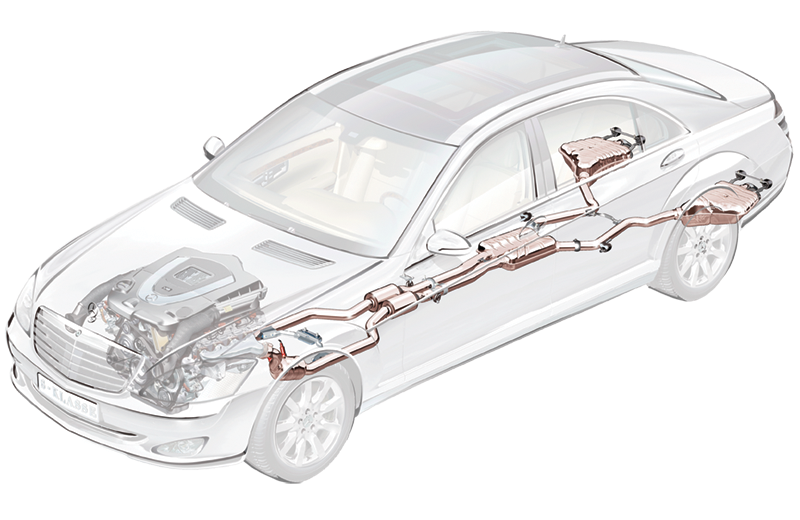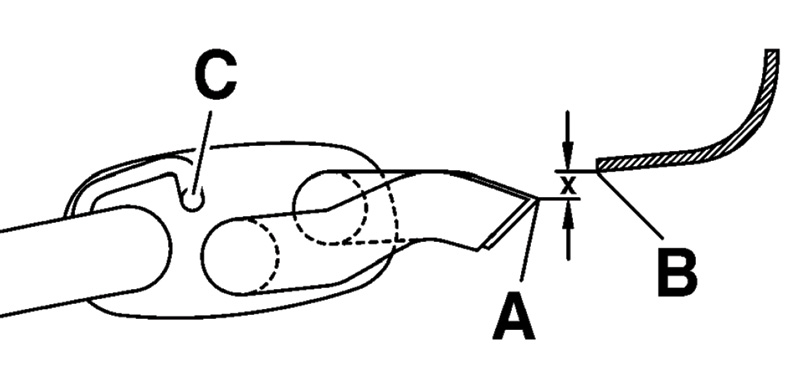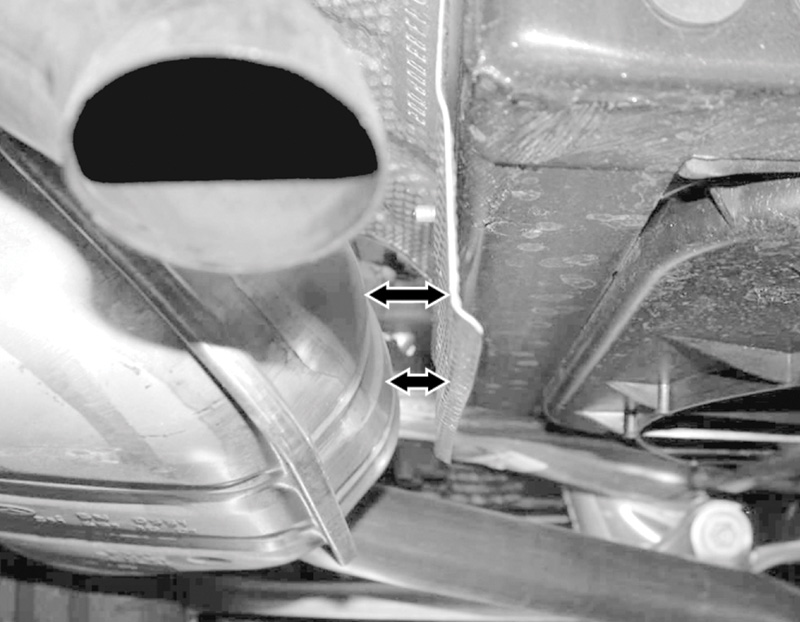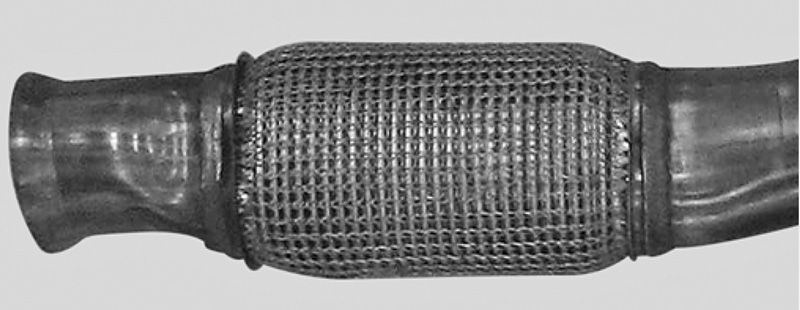Isn’t this just “bigger hammer†technology? Not anymore. And not if you don’t want comebacks.

Mercedes-Benz engineers put as much thought, effort, and testing into their exhaust systems as they do any other part of the car. And when they focus on keeping the price highly competitive, everyone wins. That’s why it makes sense to use only Genuine Mercedes-Benz parts.
How much can one write about exhaust systems that you, as an independent shop owner, don’t already know? Quite a bit, as it turns out.
If you’re buying exhaust components anywhere but from a Mercedes-Benz dealer, you may be doing both your customers and yourself a disfavor. One can argue that the aftermarket systems save money, but do they really?
Extra hour?

Are you sure that aftermarket exhaust system will line up as perfectly as a Genuine Mercedes-Benz part? The exhaust tips (A) must have a certain minimum clearance (X) from the rear bumper cover (B). Using a low-quality exhaust system or even an aftermarket rubber hanger at (C) could cause the bumper to overheat and melt, resulting in an angry customer and a new bumper at your expense. Avoid it altogether by using the real thing, at prices that may surprise you.
The first thing you need to consider is fit. Although the aftermarket can deliver exhaust systems that are close in dimensions, only a genuine Mercedes-Benz exhaust system is guaranteed to be a perfect fit, regardless of model or year. This saves you time from having to use brutal and barbaric methods to make things go together and line up properly. Is it really in your customer’s best interest to save $100 on a pipe that takes an extra hour to install?
Even small amounts of misalignment in an exhaust system can be a problem. Unexpected stresses on the pipes and hangers can not only cause gas-tight joints to loosen, but they can promote vibrations and resonances in the vehicle, leading to odd noises that can be difficult to track down. Sure, the 240D owner might not be able to hear these things (or even care), but the modern E-Class owner spent enough on the car to want it to be right. And, for your reputation’s sake, don’t you, too?
Decades of life
Then there’s longevity. Take a look at the original component you’re removing from your customer’s car. How old is it, and why did it fail? Obvious problems like accident damage from driving over something, which dents or badly scrapes the pipe, can lead to premature failure. But typically an exhaust system might be 20 years old or more before it fails to the point of needing replacement. On the other hand, we’ve see aftermarket pipes rust through in as little as a few years. The customers thought they were saving money, but, sadly, no.
Then there are repairs. We’ve had cars come in with “Franken-systems†welded together with too-small pipes and “used†catalysts, and the customer never had a clue as to why his or her Mercedes-Benz didn’t have the pep it used to have. The welds are always the weak point, where the pipe starts to corrode until, one day, it completely lets loose. It may be hard to tell a customer he or she needs a complete new exhaust system, everything from the manifold back, since the only thing readily visible – the tailpipe – looks shiny and new.
Rebuilt cats

Aftermarket systems aren’t always bent to the same specifications as the original. Maintaining proper clearance (arrows) from heat shields and other body components is critical for avoiding noises and possible overheating.
It does get easier to deliver this news, though, when you find out that Mercedes-Benz now offers most catalysts as “rebuilt†units. Of course, in following with emissions laws, the catalysts themselves are not actually re-used, but there is a core value associated with these “reman†units that ends up bringing the cost down to a very competitive point. You see, catalysts contain a small amount of platinum, which until recently was more expensive per ounce than gold. Rather than have you sell the used cats on the free market, Mercedes-Benz offers a generous allowance for their return.
Then there’s the rest of the system, the parts that more often need replacement. Catalysts often last the life of the vehicle, but pipes and mufflers tend to go after a long time, particularly in the salt-in-winter states. As we mentioned, perhaps you can save enough for a fast food meal on some parts, but Mercedes-Benz has some attractive prices for exhaust systems. And, don’t forget the hangers, gaskets, and bolts in that equation. We’re not going to claim the Genuine Mercedes-Benz parts are less expensive, but let’s face it: Quality always costs a little more. That’s why your customers drive what they drive, right?
Hard life

With the Genuine Mercedes-Benz exhaust system, replacement was as simple as the four bolts (47) at the rear of the catalytic converter pipes (5, 8). The whole system came down off the rubber hangers in one piece, and went back on just as easily, lining up with the catalysts perfectly. The time saved (and blood pressure reduced) when everything goes together perfectly by design is considerable, especially when the parts are about the same price as multi-piece, ill-fitting aftermarket components.
Let’s get down to brass tacks, and take a look at the exhaust system for a 1997 E420, for example. This car is about 20 years old, spent its life in Michigan, and it wouldn’t be considered unusual to find the exhaust system in need of replacement. To simplify the job, we decided to replace everything from the catalysts back: pipes, mufflers, hangers and hardware. On the lift, it means loosening four bolts from the dual catalyst pipes, releasing the rubber hangers, and dropping the whole system in under five minutes.
The new system is reassembled on the car, front to rear, and all of the fasteners are left little more than finger tight. We backed the car out of the work stall, let it run for a few minutes just to warm up the pipes, and then put it back on the lift to snug up the fasteners. We didn’t want to get the pipes too hot to touch, just enough to put them a little into their warm expansion zone, halfway between cold and normal operation. By doing this, we are trying to minimize stresses on the system, which can lead to unwanted noises, harmonics and vibrations – and possible failures from damage to aluminized coatings.

While the rear pipes are competitively priced, the addition of “remanufactured†catalytic converters has made these traditionally expensive parts highly competitive. Note that the rear section of this exhaust system is a single piece. Although the shipping box is fairly large, it installs in just a few minutes, as compared to the multi-piece aftermarket version.
Although we buy our parts from the local dealer, and so are unfamiliar with the pricing and availability of non-Mercedes-Benz parts, we went online to compare. One well-known aftermarket exhaust company’s website tried to sell us the exhaust system for a six-cylinder station wagon, despite carefully specifying an E420 sedan. After that eye-opener, we decided to use the Mercedes-Benz Electronic Parts Catalog, included with our STAR TekInfo subscription, to find the real “right part,†which ended up being A210 490 2721. Web sites varied in price from $880 down to $485, plus shipping.
One company that sells a replacement system has split the main pipe into two parts, adding a joint to what is originally a single-piece unit (of course, using this will require you to buy the same brand as a replacement when this one fails, since the Genuine parts will no longer fit). Their price for both halves comes out to about $420, not including mounting hardware. The list price on the Genuine Mercedes-Benz part is $570, but, of course, we get a generous discount from our dealer, since we’re one of his best customers. Let’s just say that when all is said and done, the genuine system was actually less expensive than the online “bargains.â€
Big savings

The flexible sections of Genuine Mercedes-Benz pipes are reinforced for extreme durability. Others just fold up some steel and figure it’ll last long enough. Even if the fit and durability were the same – do you believe they are? – aftermarket parts are not as much of a bargain as you thought. Just compare between your aftermarket supplier and your local dealer to see what we mean, and let your customer reap the benefits.
Now let’s just pretend we also needed both catalysts, which are called “front†exhaust pipes in the EPC. The two pipes are A210 490 4419 and A210 490 4519, with a full list price of $1,350 and $1,200, respectively. Adding the “80†suffix for a remanufactured unit, we find the list price, after returning the core, drops to about $600 and $400, respectively, with our dealer’s generous discount, or about $1,000 for the pair. Going online, we found prices for the 4419 ranging from $495 to over $1,200, and the 4519 ranged from $730 to just over $1,000.
The sensible conclusion is that the aftermarket doesn’t know about Mercedes-Benz pricing, particularly when the core value is included. The bottom line is that this E420 customer, had she needed the entire system including catalysts, could have saved around $1,100 by insisting on Genuine Mercedes-Benz parts, and we’d save the extra hour of pain-in-the-neck making things fit together caused by the aftermarket parts.
Hmm, maybe we’re dumb, but that seems like a pretty strong case to us. That being said, we’re not unaware of local sellers offering these items at slightly lower prices, but they usually end up awfully close to the dealer’s price. I can’t say what you’ll decide, but just having the right parts that are priced right, fit perfectly and go in so smoothly, last a long time, and which we can happily tell our customers are genuine Mercedes-Benz parts, well, that’s a really easy sell for us.
Before the next exhaust system job, give your dealer a call and see what he’s offering. You might be surprised.
Download PDF 〉





0 Comments